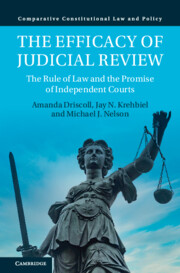Refine search
Actions for selected content:
328 results
1 - Nature and Sources of Labour Law
- from Part I - Introduction
-
- Book:
- Labour Law
- Published online:
- 02 October 2025
- Print publication:
- 20 November 2025, pp 3-45
-
- Chapter
- Export citation
Most people would use cell phones despite an emergency request for a pause
-
- Journal:
- Behavioural Public Policy , First View
- Published online by Cambridge University Press:
- 22 October 2025, pp. 1-19
-
- Article
-
- You have access
- Open access
- HTML
- Export citation
Stakeholder perceptions on the retrenchment laws in Zimbabwe
-
- Journal:
- The Economic and Labour Relations Review ,
- Published online by Cambridge University Press:
- 20 October 2025, pp. 1-18
-
- Article
-
- You have access
- Open access
- HTML
- Export citation
Consent and compliance: serviceable subjects in involuntary psychiatric commitment hearings in Paris and New York
-
- Journal:
- Law & Society Review ,
- Published online by Cambridge University Press:
- 20 October 2025, pp. 1-36
-
- Article
-
- You have access
- Open access
- HTML
- Export citation

Can the Public be Trusted?
- On the Promise and Perils of Voluntary Compliance
-
- Published online:
- 11 October 2025
- Print publication:
- 30 October 2025
-
- Book
-
- You have access
- Open access
- Export citation
1 - The Promise of Judicial Review
-
- Book:
- The Efficacy of Judicial Review
- Published online:
- 16 July 2025
- Print publication:
- 04 September 2025, pp 1-27
-
- Chapter
- Export citation
8 - Law and Social Change
-
- Book:
- Appearance, Disability and the Law
- Published online:
- 31 July 2025
- Print publication:
- 14 August 2025, pp 115-126
-
- Chapter
- Export citation
Transition to clean technologies and the impact of industrial non-compliant behavior
-
- Journal:
- Macroeconomic Dynamics / Volume 29 / 2025
- Published online by Cambridge University Press:
- 11 August 2025, e123
-
- Article
-
- You have access
- Open access
- HTML
- Export citation
Reporting activities under international humanitarian law
-
- Journal:
- International Review of the Red Cross , First View
- Published online by Cambridge University Press:
- 04 August 2025, pp. 1-38
-
- Article
-
- You have access
- Open access
- HTML
- Export citation
Perceptions of Wearable Hip Protectors among Canadian Community-Dwelling Old Adults
-
- Journal:
- Canadian Journal on Aging / La Revue canadienne du vieillissement / Volume 44 / Issue 3 / September 2025
- Published online by Cambridge University Press:
- 31 July 2025, pp. 422-428
-
- Article
-
- You have access
- Open access
- HTML
- Export citation

The Efficacy of Judicial Review
- The Rule of Law and the Promise of Independent Courts
-
- Published online:
- 16 July 2025
- Print publication:
- 04 September 2025
Chapter 1.1 - Respiratory Physiology
- from Sec 1 - Physiology
-
- Book:
- Dr Podcast Scripts for the Primary FRCA
- Published online:
- 19 June 2025
- Print publication:
- 03 July 2025, pp 1-32
-
- Chapter
- Export citation
5 - The Flexibility of Alliance Commitments
-
- Book:
- Untied Hands
- Published online:
- 03 June 2025
- Print publication:
- 26 June 2025, pp 109-143
-
- Chapter
- Export citation
92 - What Your Administration C-Suite Expects from Your Observation Unit
- from Subsection 6E - Financial – The Business of Observation Medicine
-
-
- Book:
- Observation Medicine
- Published online:
- 27 June 2025
- Print publication:
- 26 June 2025, pp 575-586
-
- Chapter
- Export citation
82 - Observation Unit Hospital Coding and Reimbursement
- from Subsection 6A - Financial – Coding and Reimbursement
-
-
- Book:
- Observation Medicine
- Published online:
- 27 June 2025
- Print publication:
- 26 June 2025, pp 520-526
-
- Chapter
- Export citation
15 - Immigration and the 100-Year Life
- from Part III - Health, Workforce, and Innovation: The Investments Required for a Healthy Lifespan
-
-
- Book:
- Law and the 100-Year Life
- Published online:
- 13 May 2025
- Print publication:
- 29 May 2025, pp 203-215
-
- Chapter
-
- You have access
- Open access
- HTML
- Export citation
7 - Navigating the Pressures of Preventive Compliance
- from Part III - Implementing Economic Governance
-
- Book:
- Balancing Pressures
- Published online:
- 02 May 2025
- Print publication:
- 22 May 2025, pp 149-169
-
- Chapter
- Export citation
6 - Supranational Bargaining, Credibility, and Preventive Surveillance
- from Part III - Implementing Economic Governance
-
- Book:
- Balancing Pressures
- Published online:
- 02 May 2025
- Print publication:
- 22 May 2025, pp 127-148
-
- Chapter
- Export citation

Balancing Pressures
- The Politics of Governing the European Economy
-
- Published online:
- 02 May 2025
- Print publication:
- 22 May 2025
Part IV - Remedies and Implementation of International Human Rights Decisions
-
- Book:
- International Human Rights Law
- Published online:
- 10 April 2025
- Print publication:
- 01 May 2025, pp 1067-1068
-
- Chapter
- Export citation
